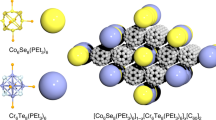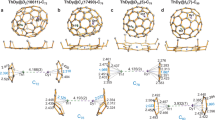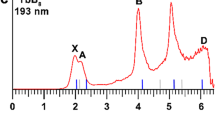Abstract
Atomically precise clusters are important for understanding structure–property relationships of bulk materials. Here we report clusters of the general formula [K(2,2,2-cryptand)]2[(μ5-Cp*RE)6(μ6-κ3:κ3:κ3-Te3)(μ-κ2:κ2-Te2)(μ3-η2:κ:κ1-Te2)(μ3-Te)3] (Cp*, pentamethylcyclopentadienyl; RE = Y, Gd, Tb, Ho, Er). They are potential precursors to rare-earth tellurides, a class of topical quantum materials with interesting thermoelectric, magnetic, semiconducting and charge density wave properties. Crystallographic analyses reveal a common trigonal antiprismatic core of RE6Te10 with six RE atoms supported by three different types of tellurido ligands, namely Te2–, Te22– dianions, and a previously unknown tri-tellurido ligand Te34–, upon which the six RE atoms are hinged into a pseudo-D3d arrangement. Density functional theory studies reveal that the linear hypervalent Te34– ion has the electronic structure characteristics of a three-centre, four-electron bond. Studies by ultraviolet–visible–near infrared spectroscopy and theoretical analyses suggest that these clusters are semiconductors with comparable band gaps to those of monocrystalline silicon and gallium arsenide.

This is a preview of subscription content, access via your institution
Access options
Subscribe to this journal
Receive 12 digital issues and online access to articles
$119.00 per year
only $9.92 per issue
Buy this article
- Purchase on Springer Link
- Instant access to full article PDF
Prices may be subject to local taxes which are calculated during checkout






Similar content being viewed by others
Data availability
Crystallographic data for the structures reported in this article have been deposited at the Cambridge Crystallographic Data Centre, under deposition numbers CCDC 2265362 (Y6Te10), 2265363 (Gd6Te10), 2265364 (Tb6Te10), 2265366 (Ho6Te10) and 2265367 (Er6Te10). Copies of the data can be obtained free of charge via https://www.ccdc.cam.ac.uk/structures/. The experimental data and the characterization data are available in the Supplementary Information. Source data are provided with this paper.
References
Cheikh, D. et al. Praseodymium telluride: a high-temperature, high-ZT thermoelectric material. Joule 2, 698–709 (2018).
Slade, T. J. et al. Charge-carrier-mediated lattice softening contributes to high ZT in thermoelectric semiconductors. Joule 5, 1168–1182 (2021).
Kogar, A. et al. Light-induced charge density wave in LaTe3. Nat. Phys. 16, 159–163 (2020).
Wang, Y. et al. Axial Higgs mode detected by quantum pathway interference in RTe3. Nature 606, 896–901 (2022).
Straquadine, J. A. W., Ikeda, M. S. & Fisher, I. R. Evidence for realignment of the charge density wave state in ErTe3 and TmTe3 under uniaxial stress via elastocaloric and elastoresistivity measurements. Phys. Rev. X 12, 021046 (2022).
Zocco, D. A. et al. Pressure dependence of the charge-density-wave and superconducting states in GdTe3, TbTe3, and DyTe3. Phys. Rev. B 91, 205114 (2015).
Lei, S. et al. High mobility in a van der Waals layered antiferromagnetic metal. Sci. Adv. 6, eaay6407 (2020).
Yang, P. T. et al. Pressured-induced superconducting phase with large upper critical field and concomitant enhancement of antiferromagnetic transition in EuTe2. Nat. Commun. 13, 2975 (2022).
Chen, P. et al. Recent advances in 2D rare earth materials. Adv. Funct. Mater. 31, 2008790 (2021).
Yumigeta, K. et al. Advances in rare-earth tritelluride quantum materials: structure, properties, and synthesis. Adv. Sci. 8, 2004762 (2021).
Jin, R., Zeng, C., Zhou, M. & Chen, Y. Atomically precise colloidal metal nanoclusters and nanoparticles: fundamentals and opportunities. Chem. Rev. 116, 10346–10413 (2016).
Jing, W. et al. Surface and interface coordination chemistry learned from model heterogeneous metal nanocatalysts: from atomically dispersed catalysts to atomically precise clusters. Chem. Rev. 123, 5948–6002 (2023).
Doud, E. A. et al. Superatoms in materials science. Nat. Rev. Mater. 5, 371–387 (2020).
Du, Y., Sheng, H., Astruc, D. & Zhu, M. Atomically precise noble metal nanoclusters as efficient catalysts: a bridge between structure and properties. Chem. Rev. 120, 526–622 (2020).
Pun, A. B., Mazzotti, S., Mule, A. S. & Norris, D. J. Understanding discrete growth in semiconductor nanocrystals: nanoplatelets and magic-sized clusters. Acc. Chem. Res. 54, 1545–1554 (2021).
Sarker, J. C. & Hogarth, G. Dithiocarbamate complexes as single source precursors to nanoscale binary, ternary and quaternary metal sulfides. Chem. Rev. 121, 6057–6123 (2021).
Pearson, R. G. Hard and soft acids and bases. J. Am. Chem. Soc. 85, 3533–3539 (1963).
Freedman, D., Emge, T. J. & Brennan, J. G. Chalcogen-rich lanthanide clusters: compounds with Te2−, (TeTe)2−, TePh, TeTePh, (TeTeTe(Ph)TeTe)5−, and [(TeTe)4TePh]9− ligands; single source precursors to solid-state lanthanide tellurides. Inorg. Chem. 41, 492–500 (2002).
Norton, K. et al. Lanthanide oxochalcogenido clusters. Dalton Trans. 39, 6794–6800 (2010).
Cary, D. R. & Arnold, J. Preparation of lanthanide tellurolates and evidence for the formation of cluster intermediates in their thermal decomposition to bulk metal tellurides. J. Am. Chem. Soc. 115, 2520–2521 (1993).
Evans, W. J., Rabe, G. W., Ziller, J. W. & Doedens, R. J. Utility of organosamarium(II) reagents in the formation of polyatomic group 16 element anions: synthesis and structure of [(C5Me5)2Sm]2(E3)(THF), [(C5Me5)2Sm(THF)]2(E), and related species (E = S, Se, Te). Inorg. Chem. 33, 2719–2726 (1994).
Zalkin, A. & Berg, D. J. Bis[bis(pentamethylcyclopentadienyl)ytterbium(III)] ditelluride. Acta Crystallogr. C 44, 1488–1489 (1988).
Cisar, A. & Corbett, J. D. Synthesis and crystal structure of a salt containing the tritelluride(2–) anion. Inorg. Chem. 16, 632–635 (1977).
Smiles, D. E., Wu, G., Hrobárik, P. & Hayton, T. W. Use of 77Se and 125Te NMR spectroscopy to probe covalency of the actinide-chalcogen bonding in [Th(En){N(SiMe3)2}3]− (E = Se, Te; n = 1, 2) and their oxo-uranium(VI) congeners. J. Am. Chem. Soc. 138, 814–825 (2016).
Yi, C., Xu, Z., Chen, L. & Ren, W. Cerocene and lanthanocene chalcogenides: synthesis, structure, and luminescence. Inorg. Chem. 61, 5373–5379 (2022).
Hillier, A. C., Liu, S.-Y., Sella, A. & Elsegood, M. R. J. (PhTe)3−: the anionic tellurium analogue of I3−. Angew. Chem. Int. Ed. 38, 2745–2747 (1999).
Pyykkö, P. & Atsumi, M. Molecular single-bond covalent radii for elements 1–118. Chem. Eur. J. 15, 186–197 (2009).
Braïda, B. & Hiberty, P. C. The essential role of charge-shift bonding in hypervalent prototype XeF2. Nat. Chem. 5, 417–422 (2013).
Svensson, P. H. & Kloo, L. Synthesis, structure, and bonding in polyiodide and metal iodide−iodine systems. Chem. Rev. 103, 1649–1684 (2003).
Evans, W. J., Rabe, G. W., Ansari, M. A. & Ziller, J. W. Polynuclear lanthanide complexes: formation of a selenium-centered Sm6 complex, [{(C5Me5)Sm}6Se11]. Angew. Chem. Int. Ed. 33, 2110–2111 (1994).
Zubarev, D. Y. & Boldyrev, A. I. Developing paradigms of chemical bonding: adaptive natural density partitioning. Phys. Chem. Chem. Phys. 10, 5207–5217 (2008).
Sergeeva, A. P., Zubarev, D. Y., Zhai, H.-J., Boldyrev, A. I. & Wang, L.-S. A photoelectron spectroscopic and theoretical study of B16− and B162−: an all-boron naphthalene. J. Am. Chem. Soc. 130, 7244–7246 (2008).
te Velde, G. et al. Chemistry with ADF. J. Comput. Chem. 22, 931–967 (2001).
Adamo, C. & Barone, V. Toward reliable density functional methods without adjustable parameters: the PBE0 model. J. Chem. Phys. 110, 6158–6170 (1999).
Van Lenthe, E. & Baerends, E. J. Optimized Slater-type basis sets for the elements 1–118. J. Comput. Chem. 24, 1142–1156 (2003).
van Lenthe, E., van Leeuwen, R., Baerends, E. J. & Snijders, J. G. Relativistic regular two-component Hamiltonians. Int. J. Quantum Chem. 57, 281–293 (1996).
Michalak, A., Mitoraj, M. & Ziegler, T. Bond orbitals from chemical valence theory. J. Phys. Chem. A 112, 1933–1939 (2008).
Mitoraj, M. P., Michalak, A. & Ziegler, T. A combined charge and energy decomposition scheme for bond analysis. J. Chem. Theory Comput. 5, 962–975 (2009).
Becke, A. D. & Edgecombe, K. E. A simple measure of electron localization in atomic and molecular systems. J. Chem. Phys. 92, 5397–5403 (1990).
Bader, R. F. W. Atoms in Molecules: A Quantum Theory (Oxford Univ. Press, 1990).
Lu, T. & Chen, F. Multiwfn: a multifunctional wavefunction analyzer. J. Comput. Chem. 33, 580–592 (2012).
Lu, J.-B. et al. Norm-conserving pseudopotentials and basis sets to explore lanthanide chemistry in complex environments. J. Chem. Theory Comput. 15, 5987–5997 (2019).
Van Gisbergen, S. J. A., Snijders, J. G. & Baerends, E. J. Implementation of time-dependent density functional response equations. Comput. Phys. Commun. 118, 119–138 (1999).
Makuła, P., Pacia, M. & Macyk, W. How to correctly determine the band gap energy of modified semiconductor photocatalysts based on UV–Vis spectra. J. Phys. Chem. Lett. 9, 6814–6817 (2018).
Woods-Robinson, R. et al. Wide band gap chalcogenide semiconductors. Chem. Rev. 120, 4007–4055 (2020).
Han, S.-S., Yu, S.-X., Liu, W. & Guo, S.-P. KNa0.78Eu0.27In3.80B12S12: a novel hexanary thioborate featuring a B12S12 cluster and diverse InSx (x = 4, 5, 6) units. Inorg. Chem. Front. 9, 2462–2469 (2022).
Chen, Z.-X., Liu, W. & Guo, S.-P. A review of structures and physical properties of rare earth chalcophosphates. Coord. Chem. Rev. 474, 214870 (2023).
Nayak, P. K. & Cahen, D. Updated assessment of possibilities and limits for solar cells. Adv. Mater. 26, 1622–1628 (2014).
Bootharaju, M. S. et al. Structure of a subnanometer-sized semiconductor Cd14Se13 cluster. Chem 8, 2978–2989 (2022).
Huang, W., Upton, B. M., Khan, S. I. & Diaconescu, P. L. Synthesis and characterization of paramagnetic lanthanide benzyl complexes. Organometallics 32, 1379–1386 (2013).
Evans, W. J., Kozimor, S. A., Ziller, J. W. & Kaltsoyannis, N. Structure, reactivity, and density functional theory analysis of the six-electron reductant, [(C5Me5)2U]2(μ-η6:η6-C6H6), synthesized via a new mode of (C5Me5)3M reactivity. J. Am. Chem. Soc. 126, 14533–14547 (2004).
Bergbreiter, D. E. & Killough, J. M. Reactions of potassium-graphite. J. Am. Chem. Soc. 100, 2126–2134 (1978).
Dolomanov, O. V., Bourhis, L. J., Gildea, R. J., Howard, J. A. K. & Puschmann, H. OLEX2: a complete structure solution, refinement and analysis program. J. Appl. Cryst. 42, 339–341 (2009).
Sheldrick, G. SHELXT – integrated space-group and crystal-structure determination. Acta Crystallogr. A 71, 3–8 (2015).
Sheldrick, G. Crystal structure refinement with SHELXL. Acta Crystallogr. C 71, 3–8 (2015).
Acknowledgements
This work was supported by the National Natural Science Foundation of China (92261203, 22101116, 21971106 and 22033005), the Key Laboratory of Rare-Earth Chemistry of Guangdong Higher Education Institutes (2022KSYS006), the Stable Support Plan Programme of Shenzhen Natural Science Fund (20200925161141006), the Shenzhen Fundamental Research Programme (JCYJ20220530115001002 and JCYJ20220818100417037), the National Key R&D Project (2022YFA1503900 and 2022YFA1503000) and the Guangdong Provincial Key Laboratory of Catalysis (2020B121201002). Computational resources are provided by the Center for Computational Science and Engineering and the CHEM high-performance supercomputer cluster at SUSTech. We thank X.-Y. Chang for assistance with single-crystal X-ray diffraction studies and discussion. We also thank Z. Quan, L. Mao, Z. Luo and Y. Liu for assistance with the solid-state UV-Vis-NIR characterization and discussion.
Author information
Authors and Affiliations
Contributions
Y.-S.D. synthesized and characterized the compounds with the assistance of L.L.; Z.Z. designed the research project and directed the experiments. X.-L.J. performed the DFT computations under the guidance of C.-Q.X. and J.L. The writing of the paper was completed using contributions from all authors who have also approved the final version of the paper.
Corresponding authors
Ethics declarations
Competing interests
The authors declare no competing interests.
Peer review
Peer review information
Nature Synthesis thanks the anonymous reviewers for their contribution to the peer review of this work. Primary Handling Editor: Alexandra Groves, in collaboration with the Nature Synthesis team.
Additional information
Publisher’s note Springer Nature remains neutral with regard to jurisdictional claims in published maps and institutional affiliations.
Supplementary information
Supplementary Information
Supplementary Tables 1–9, Figs. 1–12, Discussion and References.
Supplementary Data 1
Crystallographic data of Y6Te10, CCDC 2265362.
Supplementary Data 2
Crystallographic data of Gd6Te10, CCDC 2265363.
Supplementary Data 3
Crystallographic data of Tb6Te10, CCDC 2265364.
Supplementary Data 4
Crystallographic data of Ho6Te10, CCDC 2265366.
Supplementary Data 5
Crystallographic data of Er6Te10, CCDC 2265367.
Source data
Source Data Fig. 5
EDA–NOCV results of Y6Te10.
Source Data Fig. 6
Data of solid-state UV-Vis-NIR.
Rights and permissions
Springer Nature or its licensor (e.g. a society or other partner) holds exclusive rights to this article under a publishing agreement with the author(s) or other rightsholder(s); author self-archiving of the accepted manuscript version of this article is solely governed by the terms of such publishing agreement and applicable law.
About this article
Cite this article
Ding, YS., Jiang, XL., Li, L. et al. Atomically precise semiconductor clusters of rare-earth tellurides. Nat. Synth (2024). https://doi.org/10.1038/s44160-024-00511-x
Received:
Accepted:
Published:
DOI: https://doi.org/10.1038/s44160-024-00511-x
This article is cited by
-
Efficient reduction method enables access to rare-earth telluride clusters
Communications Chemistry (2024)



